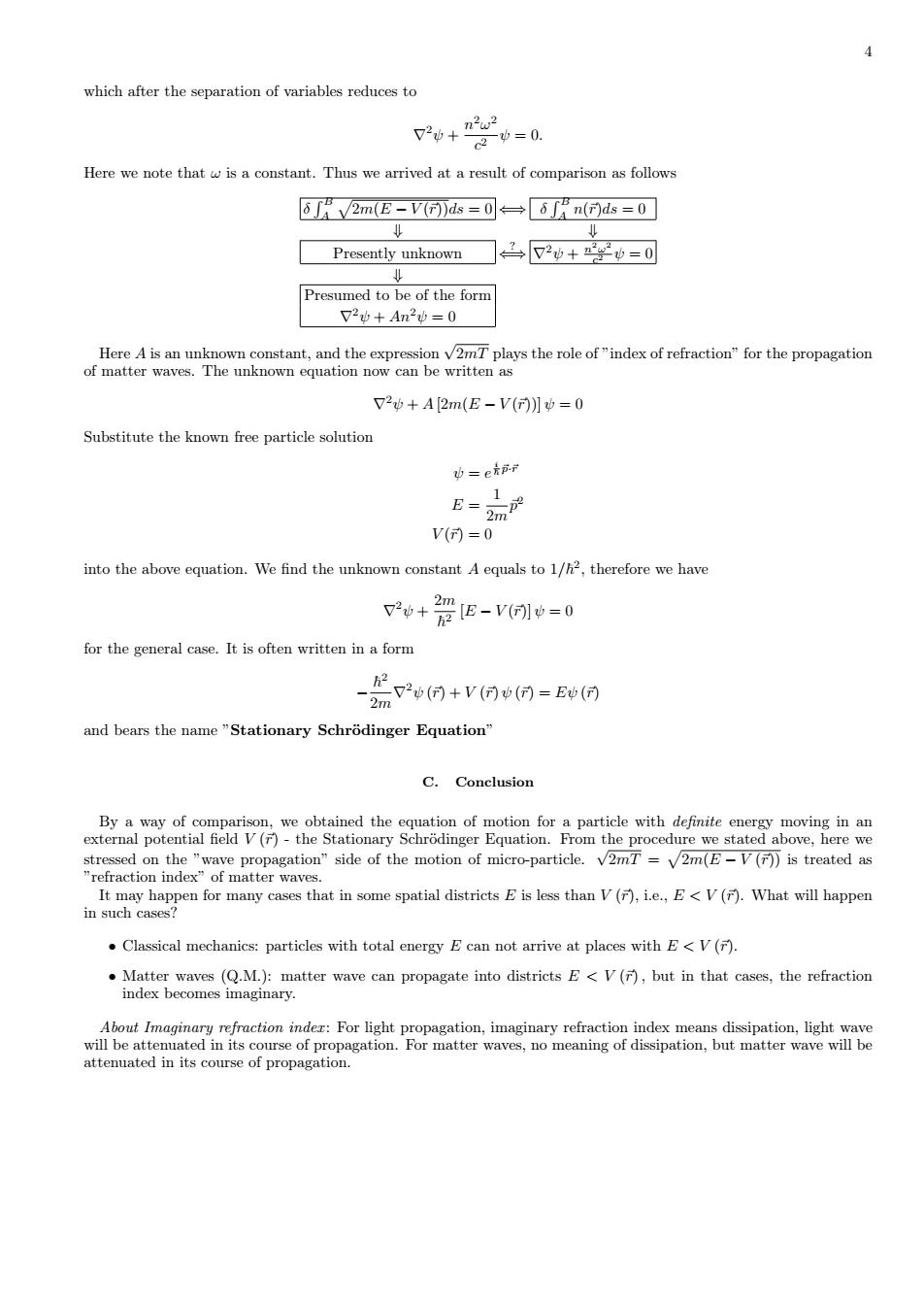正在加载图片...

which after the separation of variables reduces to w+-0 Here we note thatis a constant.Thus we arrived at a result of comparison as follows 3 y2m(E-V(F))ds=06 n()ds=0 Pruko☐名2+妥=司 威the e e广6cmea 720+A2m(E-V(川中=0 Substitute the known free particle sotion -er into the above equation.We find the unknown constant A equals to1/,therefore we have 2+0E-V=0 o the general cas.It inaform -+v= and bears the name"Stationary Schrodinger Equation" C.Conclusion quation. rom ti side of the motion of micro-particl.V2mvm(V(trented a refraction index of matter wave forhat ialdtricstV()What appe .Clasical mechanics:particles with total energy Ecan not arrive at places with E<V( r),t at the attenuated in its course of propagation.4 which after the separation of variables reduces to ∇2ψ + n 2ω 2 c 2 ψ = 0. Here we note that ω is a constant. Thus we arrived at a result of comparison as follows δ ∫ B A √ 2m(E − V (⃗r))ds = 0 ⇐⇒ δ ∫ B A n(⃗r)ds = 0 ⇓ ⇓ Presently unknown ? ⇐⇒ ∇2ψ + n 2ω 2 c 2 ψ = 0 ⇓ Presumed to be of the form ∇2ψ + An2ψ = 0 Here A is an unknown constant, and the expression √ 2mT plays the role of ”index of refraction” for the propagation of matter waves. The unknown equation now can be written as ∇2ψ + A [2m(E − V (⃗r))] ψ = 0 Substitute the known free particle solution ψ = e i ~ ⃗p·⃗r E = 1 2m ⃗p 2 V (⃗r) = 0 into the above equation. We find the unknown constant A equals to 1/~ 2 , therefore we have ∇2ψ + 2m ~ 2 [E − V (⃗r)] ψ = 0 for the general case. It is often written in a form − ~ 2 2m ∇2ψ (⃗r) + V (⃗r) ψ (⃗r) = Eψ (⃗r) and bears the name ”Stationary Schr¨odinger Equation” C. Conclusion By a way of comparison, we obtained the equation of motion for a particle with definite energy moving in an external potential field V (⃗r) - the Stationary Schr¨odinger Equation. From the procedure we stated above, here we stressed on the ”wave propagation” side of the motion of micro-particle. √ 2mT = √ 2m(E − V (⃗r)) is treated as ”refraction index” of matter waves. It may happen for many cases that in some spatial districts E is less than V (⃗r), i.e., E < V (⃗r). What will happen in such cases? • Classical mechanics: particles with total energy E can not arrive at places with E < V (⃗r). • Matter waves (Q.M.): matter wave can propagate into districts E < V (⃗r), but in that cases, the refraction index becomes imaginary. About Imaginary refraction index : For light propagation, imaginary refraction index means dissipation, light wave will be attenuated in its course of propagation. For matter waves, no meaning of dissipation, but matter wave will be attenuated in its course of propagation